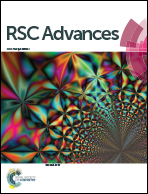Targeted and controlled drug delivery using a temperature and ultra-violet responsive liposome with excellent breast cancer suppressing ability†
Abstract
Drug delivery systems (DDS) with favorable serum stability, high intra-tumor accumulation and tumor specific drug release are highly desired for promoting chemotherapeutic efficacy. However, a more stable DDS means it is more difficult to release its content, and vice versa. In order to resolve this conflict, a Fab conjugated thermo-responsive liposome (FCTRL) based on 1,2-bis(10,12-tricosadiynoyl)-sn-glycero-3-phosphocholine (DC8,9PC) and P(IPPAm-co-DMAAm)-b-PLA diblock copolymer (PPDC) was developed in this study. DC8,9PC is a type of phospholipid, which can form intermolecular cross-linking within the liposomal bilayer by ultra-violet irradiation, contributing to superior serum stability in the blood vessels. PPDC is a thermo-responsive block copolymer, which demonstrates temperature controlled ON–OFF drug release with a volume phase transition temperature (VPTT) of approximately 38.5 °C. The well modified FCTRLs are of the desired particle size, drug loading content and drug release profile. The surface morphology and pharmacokinetics were also characterized. The cellular uptake and intracellular accumulation of FCTRL are significantly promoted by its proper size, temperature regulated passive and Fab navigated active targeting. With the co-operation of all the above superiorities, the FCTRL DDS demonstrates exceptional excellent tumor suppression abilities against breast cancer in both in and ex vivo experiments, which merits further investigation in the clinic.


 Please wait while we load your content...
Please wait while we load your content...